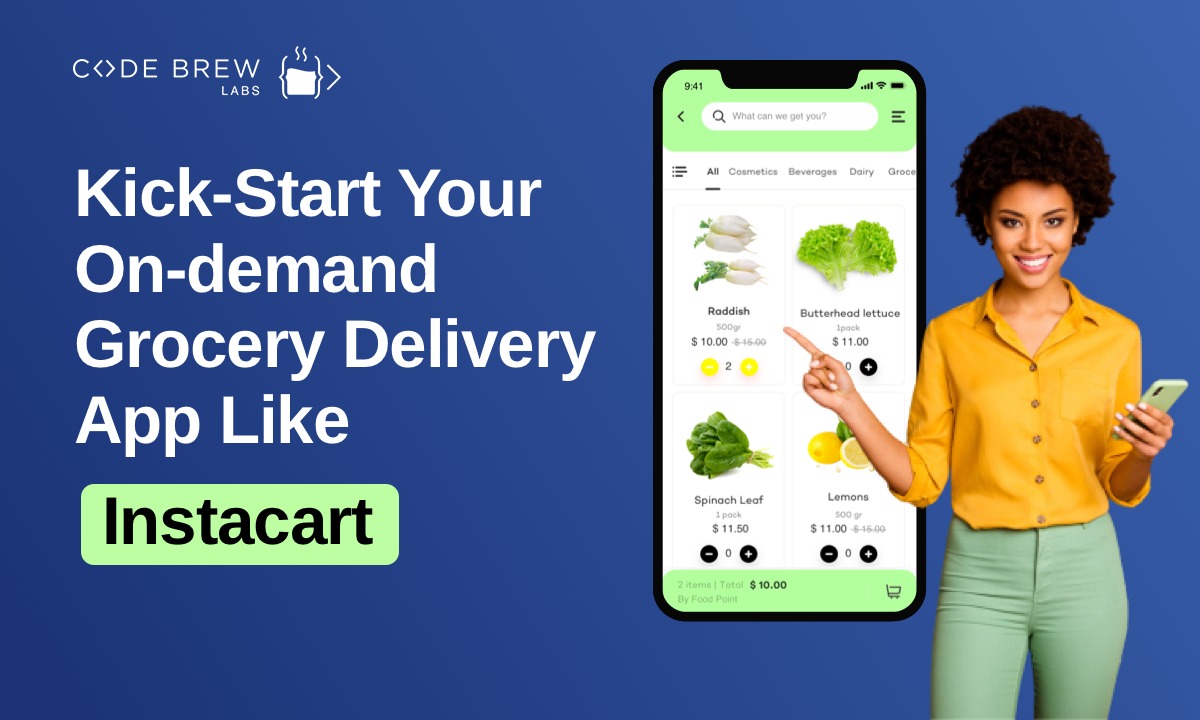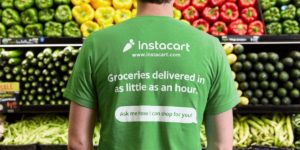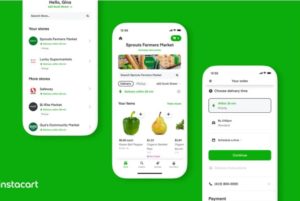
The online grocery marketplace is one of the offsprings of technological advancements that has witnessed massive growth in recent years. With covid induced lockdowns, the once luxury service has now become a necessity, owing to the demands of contactless home delivery.
Table of Contents
Millions of US customers tried out the online grocery shopping experience for the first time during the pandemic. As a result, applications like Instacart have faced the warmth of the boom, with profit margins soaring high for the first time in 2020, since its launch.
According to Statista, the company recorded a 218% increase in the number of downloads in 2020. The whopping success of this online grocery application has encouraged many entrepreneurs to understand the business and revenue model and use it to build a profiteering online business.
This article aims to guide you to help you successfully launch an app like Instacart. First, let’s start by understanding what Instacart is and what are its key elements?

Instacart is an on-demand grocery delivery platform and a brainchild of Apoorva Mehta, an ex-Amazon employee. The popularity of this grocery giant is such that around 85% of the US households and 60% of Canadian households use Instacart for grocery shopping.
In one of the latest announcements, the company raised $600 million at a $7.6 billion valuation. The unique “no-inventory” business model plays a key role in propelling its growth and popularity. During the pandemic, Instacart has been instrumental in helping people get essential groceries without them having to step out and exposing themselves to the virus.
The unique selling point of Instacart is its fast doorstep delivery of grocery items from the local shops. InstaCart’s business model is a three-tier customer strategy. Before we plunge into decoding the model, let’s understand how Instacart works.
But there’s more to it. To draw the business canvas, you need to understand what a three-tiered customer strategy is.
You can pinpoint the three customers segments of Instacart as:
They place orders via InstaCart’s mobile app or web app. So you can say that they are the target customers. The whole idea of delivering groceries focuses on serving them. Therefore, the application is built to be intuitive, so the buyers can easily add their favourite items to the cart without confusion.
Instacart offers various store coupons and other perks to its buyers to attract more buyers to download and use the app.
Buyers can also choose from the two delivery options:
They are the ones who deliver the orders for the buyers. InstaCart has a dedicated application where they review and accept orders. They work with the platform to ultimately ensure faster and accurate deliveries. They earn through Instacart on an hourly basis and from the tip that the buyer might give.
The app also allows them to follow up and interact with the buyer and steer clear of any confusion during the process. In addition, InstaCart shoppers can choose how they want to associate themselves with the platform.
They are the local grocery stores or retail chains that sign up to the platform and enlist their products. Buyers look through their offers and choose the best which suits them. It, in turn, helps them to boost their sales as well.

Like any on-demand delivery app, Instacart offers benefits not only for the company itself but also to its three customers. While the buyers need a fast and reasonably priced order fulfilment, the shoppers and shops sign up to expand their financial income sources.
Therefore, to attract more buyers, it uses an affordable pricing scheme. For example, it does not charge a cent as delivery fees from a first-time buyer. Similarly, to bring in more shoppers, they have a decent hourly payment scheme, and for the grocery shops who are the suppliers, they give them the freedom to run promotional services.
To understand how Instacart manages to keep all its promises and still become a billion-dollar company in few years, let’s break down its income source at the molecular level:
Instacart charges delivery fees from its buyers to deliver groceries to their doorstep. While a percentage of the fees goes out to the shopper, the rest adds to the company’s account.
The delivery charges vary for members and non-members. Also, the buyer may have to pay a little extra if they want the same-day delivery. The company also charges a certain amount if the estimated weight of the shopping cart exceeds 50lbs.
This fee is applicable when a buyer opts for the curbside delivery. However, InstaCart exempts them from the service fees. For a premium member, the company does not charge any pickup fees as well.
However, non-members and non-premium members need to pay a sum as pickup fees which are almost the same as their delivery fees.
This is again a common source of income that every on-demand app leverages. InstaCart charges services fees differently for users without premium membership and those with one. The fees intend to cover up the operating expenses that include customer support, shop management, etc.
InstaCart charges a particular sum as subscription fees, either monthly or yearly, from the buyers to become premium members. In return, it offers lucrative benefits for buyers like exemption from pickup fees, reduced service charges, additional promotional offers, etc.
As Instacart enjoys tremendous traffic, it helps its partner stores or products to promote their brand on the platform. It generates revenue by charging a minimum sum as commission every time a customer buys or engages with the promoted item.
A grocery delivery app like InstaCart is successful only when there are enough people to buy the products from their multi-vendor store. Therefore, to attract as many customers as possible, Instacart lets its users buy a gift card for their loved ones and encourages them to use the platform. The validity of the gift card depends on the value.
In simple terms, the overall motive of the Instacart model is to grow together with their key partners, i.e., the three tired customers- buyers, shoppers, and the shop.
If you want to replicate a similar business and revenue model, the first step is to understand the likings of your partners and create a monetary strategy that benefits your company and your customers.
The on-demand grocery stores are now gaining popularity worldwide owing to safety concerns and the new normal. You must consider launching a multi-vendor, on-demand grocery app.
All you need is a stellar business plan like InstaCart that outshines your competitors. If not having the hard coding skills to build an impeccable, user-friendly grocery app is holding you back, then worry no more.
Visit CodeBrew’s array of services and testimonials of happy clients who have successfully created various on-demand apps on our platform. Get in Touch with the industry experts by booking a free demo or consultation, and we will help you launch your dream app ASAP.
